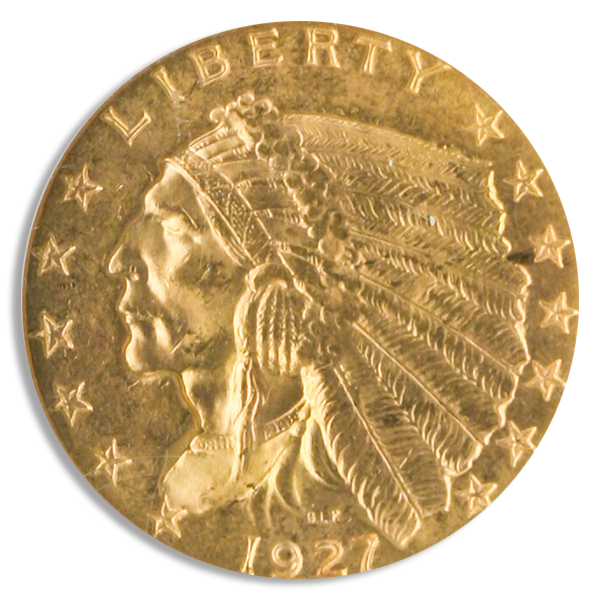$2 1/2 Indian Certified MS63 (Dates/Types Vary)









Introduction
The $2 ½ Indian, Certified MS63, offers a captivating overview of numismatic treasures that have withstood the test of time. These coins are a testament to the artistic brilliance of Bela Lyon Pratt and a transformative era in American coinage. Their distinctive incuse design, where the main elements are recessed below the coin's surface, sets them apart from traditional coinage. Graded as MS63, or "Mint State 63," these coins are certified to be in uncirculated condition with only minor imperfections.
History
The $2 ½ Indian was minted from 1908 to 1929 and holds a significant place in American numismatic history. These coins feature a unique and innovative incuse design, where the main elements are recessed below the coin's surface, creating a distinct appearance. The $2 ½ Indian was introduced as part of President Theodore Roosevelt's efforts to elevate the artistic appeal of American currency, alongside the Saint-Gaudens Double Eagle and other coin designs of that time. These coins were struck at various mints throughout their production, resulting in varying dates and mint marks. The $2 ½ Indian are highly regarded by collectors and enthusiasts for their unique design, historical significance, and the artistic expression they represent during this transformative era in American coinage history.
Design
The design of the $2 ½ Indian showcases the unique incuse style. These coins feature a captivating obverse portrayal of a Native American chief adorned with a feathered headdress, encircled by thirteen stars representing the original colonies. The deeply recessed design adds depth and dimension to the image, giving it a sculpted and intricate look. On the reverse, a majestic eagle stands on a bundle of arrows and an olive branch, surrounded by the inscriptions "UNITED STATES OF AMERICA" and "E PLURIBUS UNUM." The reverse design, also incuse, complements the obverse, resulting in a visually striking overall presentation.
The $2 ½ Indian, Certified MS63, offers a captivating overview of numismatic treasures that have withstood the test of time. These coins are a testament to the artistic brilliance of Bela Lyon Pratt and a transformative era in American coinage. Their distinctive incuse design, where the main elements are recessed below the coin's surface, sets them apart from traditional coinage. Graded as MS63, or "Mint State 63," these coins are certified to be in uncirculated condition with only minor imperfections.
History
The $2 ½ Indian was minted from 1908 to 1929 and holds a significant place in American numismatic history. These coins feature a unique and innovative incuse design, where the main elements are recessed below the coin's surface, creating a distinct appearance. The $2 ½ Indian was introduced as part of President Theodore Roosevelt's efforts to elevate the artistic appeal of American currency, alongside the Saint-Gaudens Double Eagle and other coin designs of that time. These coins were struck at various mints throughout their production, resulting in varying dates and mint marks. The $2 ½ Indian are highly regarded by collectors and enthusiasts for their unique design, historical significance, and the artistic expression they represent during this transformative era in American coinage history.
Design
The design of the $2 ½ Indian showcases the unique incuse style. These coins feature a captivating obverse portrayal of a Native American chief adorned with a feathered headdress, encircled by thirteen stars representing the original colonies. The deeply recessed design adds depth and dimension to the image, giving it a sculpted and intricate look. On the reverse, a majestic eagle stands on a bundle of arrows and an olive branch, surrounded by the inscriptions "UNITED STATES OF AMERICA" and "E PLURIBUS UNUM." The reverse design, also incuse, complements the obverse, resulting in a visually striking overall presentation.
Comparison Chart







 Quick View
Quick View





